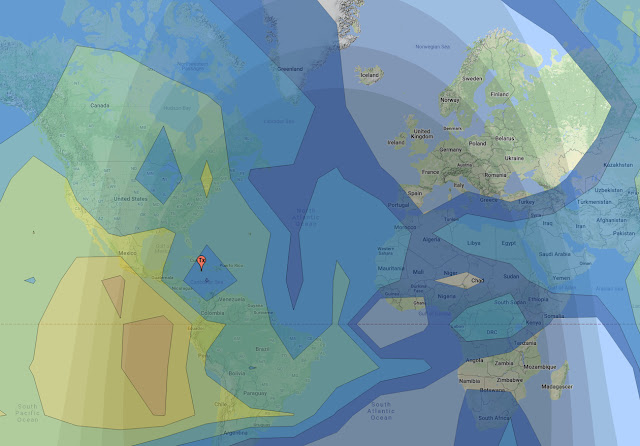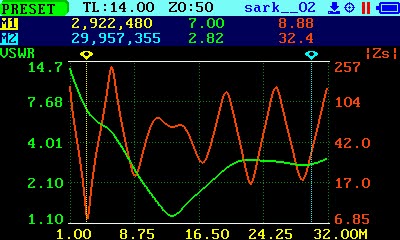Most of us have heard about trees being used as antennas. I most recently heard about them a year or two ago via blogging colleague, PE4BAS, who had a degree of success, as I seem to remember. Tree antennas featured very early on in the story of radio, as you can see here, from 1919.
Well, with Storm Ellen rapidly approaching North Wales, but the conditions fairly dry and warm nevertheless, I decided to try out my own tree antenna.
Usefully, there is a small plantation of ~20m-tall conifers only a few minutes away from the house, and which happens also to be along the shore of a freshwater reservoir.
 |
Tree connected up.
|
I had a look at some other experiments, and decided that the usual method used to energise the tree (if, indeed, it is being energised at all), of a coiled 'spring' of wire wrapped around the trunk, is suspect.
Suspect, because when using WSPR to assess antenna performance, even a short piece of radiating wire can fairly easily result in spots being reported. For sure, a matched coil around a tree risks confusing the picture of where the radiation is in fact coming from.
Because the conifers are cut down every 25 years or so and have little or no ecological importance locally, and won't anyway be injured to any degree, I had no qualms in inserting a 150mm stainless steel screw into one of them. Stainless isn't strictly necessary, but at least it is almost entirely non-magnetic and therefore won't 'steal' any energy to reorganise domains as the RF flows.
I clipped the screw via a ~1.5m-long wire to a 4:1 current balun - a direct connection without a step-down balun didn't yield a very good natural match anywhere on the bands. The other side of the balun went to a copper ground tube.
Very surprisingly, I found an excellent match in the 10-14MHz range, which was very useful due to the large amount of WSPR activity there. Here's the full HF sweep from the SARK analyser; red is impedance, green the SWR. Not suprisingly, the match range is quite broad:
I operated at 14MHz, where transmission confirmed at the rig that the matching was as indicated by the analyser:
 |
Good match!
|
The results were very interesting. Transmit was pretty poor; 1W out was only getting as far as EA8BFK and central Europe, although propagation was quite poor at the time. The tree managed -29dB at EA8BFK, against a median for the 17 other UK/Irish stations of -20dB. Not a good performance, but perhaps suprising that a tree was only 9dB down against full wire antennas.
But receive was another story. Here, the performance could be outstanding. For example, I was amazed to receive DP0GVN at -27dB at this time of day - one of only four total European stations, none at all from the UK, hearing him: F4GFZ (-27db), EA8BFK (-25dB), HB9TMC (-25dB). Quite remarkable!
 |
DP0GVN appears on the WSPR decode screen!
|
The other excellent spot was AA7FV, at -30dB for the tree antenna, when there were again no UK stations at all hearing him, and only a small number from anywhere in Europe: OZ7IT (-19dB), HB9TMCC (-26dB), OE9GHV (-21dB), ON5KQ (-25dB), OE9HLH (-23dB).
LU1EGT was another surprise spot. Here, there were a good number of UK spotters, with a median received signal of -24.5dB. The tree heard him at -20dB.
 |
TX (green calls), and RX (red) for my tree antenna. All but EA8BFK TX spots are hidden in the European mess.
|
KK1D came in to the tree at -18dB, against a median UK received signal (only two others) of -25dB.
W3BCW was heard by no UK station, except for my tree, at -24dB. Across Europe, DK0DLR was hearing at -28dB, OZ7IT at -20dB, DK4RW/1 at -20dB, DF4UE/P at -24dB, OE9GHV at -24dB, DK6UG at -21dB, and LX1DQ at -18dB.
KB1HKN was heard by 13 other UK stations, with a median reception of -22dB against the tree's -18dB.
At the moment, I suspect the tree is doing very little, except perhaps as a grounding point for one side of the feed from the balun. The feed wires and ground stake is, I think, acting as a kind of short, grounded dipole, albeit one that seems to receive very well at DX distances.
Later today, I'm going to try and connect two trees, side-by-side, using as short connecting wires from the balun between them as possible. I'm expecting this to work very poorly; we shall just have to wait and see! Another permutation will be to connect both sides of the feed wires, running along the ground and grounded at copper tubes, which I am sure will be as effective, and probably more effective, than using trees.
RESULT UPDATE: Using two trees proved problematic. Although the impedance was quite close to 50 Ohms using a 4:1 balun, I couldn't match it with the internal ATU, and there was no time or equipment available to try and resolve this.
In fact, I only got the results thanks to a pair of scissors. I accidentally connected the rig up with the wrong polarity, blowing a 25A in-line fuse. Having somehow not packed any spares, I had to improvise with scissors blades to make the connection!
 |
When portable, you have to be either prepared, or resourceful! Coping with a 25A fuse blow (not recommended normally, obviously).
|
Listening with the trees, regardless gave the following indicative result for VK3MO: UK median (18 stations): -14.5dB; 2-tree antenna: -8dB. With a grounded short dipole (2.5m per leg) into a 4:1 balun laid flat on the ground, the UK median (17 stations) was -24dB, the ground dipole -15dB. I suspect most of the advantage I saw in the woods was the result of an extremely low noise background, relative to practically everybody else. Some might have been down to the anyway quiet nature of ground dipoles.
Whilst the tree antenna is pretty much a dud, and the ground dipole not a scintillating perfomer either, they are both capable of producing good results relative to antennas located where most of us live. But, of course, if you are out in the coutry, you are better erecting a full dipole or 1/4 vertical in this low-noise environment, rather than acting like some kind of Yeti in the trees!
It's interesting to look back at the 1919 material, where nails were driven fairly high up trees, with consequently fairly long feed wires hanging down from them. It's difficult not to conclude that the signals that were heard - and sent - using the 'tree antennas' were achieved from those vertical feed wires, not the tree itself.
 |
The two-tree antenna, coupled by 40cm legs to a 4:1 balun. Not a success, although it still yielded stronger signals than the median UK reception of VK3MO.
|
 |
The grounded ~2.5m legs of the ground dipole.
|
As for the coil, there was no good, natural match anywhere to be found, so I will have to come back and look at that again when I have more time. For now, here's the SARK sweep for it, which at least shows that matching the fairly flat, modestly high SWR, should not be too problematic for most bands from about 5MHz and above.

















































